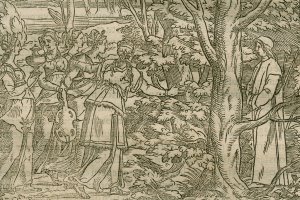
Enjoy a selection of manuscripts and early printed books from the 15th to the 17th centuries that were illustrated with illuminations and woodcuts. Throughout the European Renaissance (1300-1700), many book illustrations were exclusively ornamental, while others focused on enhancing the meaning of the text. However, as the pages on display attest, all these illustrations share a common ground: they reveal the aesthetic and intellectual fashions first proposed by Italian artists of the 1400s, who were strongly committed to the recovery of the past of classical antiquity.
The word “Illumination,” from the Latin illuminare, “to enlighten or to illuminate,” refers to the embellishment of a manuscript or early printed book with luminous colors, notably gold and silver. This illumination was prominent in the frontispiece, or first page of text, which included the decoration of its borders and initial letter, and even miniatures, that is, scenes with an independent narrative. With the introduction of movable-type printing in 1454, these illuminations would be gradually replaced by woodcuts, which were printed from a woodblock that had been cut by knife along the grain of the wood.
Available during Hatcher Gallery Exhibit Room hours (https://myumi.ch/2m7d4).
Join us on September 13 for a talk by Pablo Alvarez, curator of the exhibit.
The word “Illumination,” from the Latin illuminare, “to enlighten or to illuminate,” refers to the embellishment of a manuscript or early printed book with luminous colors, notably gold and silver. This illumination was prominent in the frontispiece, or first page of text, which included the decoration of its borders and initial letter, and even miniatures, that is, scenes with an independent narrative. With the introduction of movable-type printing in 1454, these illuminations would be gradually replaced by woodcuts, which were printed from a woodblock that had been cut by knife along the grain of the wood.
Available during Hatcher Gallery Exhibit Room hours (https://myumi.ch/2m7d4).
Join us on September 13 for a talk by Pablo Alvarez, curator of the exhibit.